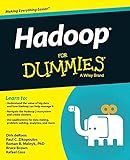Best Hadoop Cluster Solutions to Buy in December 2025
To divide data on a cluster in Hadoop, you can use the Hadoop Distributed File System (HDFS) to store and manage the data. HDFS divides the data into blocks, which are then distributed across the cluster nodes for processing. You can also use Hadoop's MapReduce framework to distribute the processing of the data across multiple nodes in the cluster. This allows for parallel processing of the data, which can significantly speed up the processing time for large datasets. Additionally, you can use file partitioning techniques, such as partitioning by key or range, to divide the data into smaller chunks for processing on the cluster nodes. Overall, dividing data on a cluster in Hadoop involves breaking down the data into smaller pieces and distributing those pieces across the cluster for efficient processing.
How to optimize data storage on Hadoop clusters?
- Use compression: Compressing data before storing it on Hadoop clusters can significantly reduce the amount of storage space required. Popular compression algorithms like Gzip, Snappy, or LZO can be used to compress data while storing it on Hadoop.
- Partition data: Partitioning data based on certain criteria can help optimize storage on Hadoop clusters. By partitioning data into smaller chunks, you can improve query performance and reduce the amount of data that needs to be processed.
- Use columnar storage formats: Columnar storage formats like Apache Parquet or Apache ORC are more efficient for storing and querying data on Hadoop clusters compared to row-based formats. These formats store data column-wise, making it easier to read only the required columns for a query.
- Remove unnecessary data: Regularly clean up and remove unnecessary data from Hadoop clusters to free up storage space. This includes deleting old or redundant data, temporary files, or unused datasets.
- Use data tiering: Implement data tiering strategies to store frequently accessed or critical data on faster storage mediums like SSDs while moving less frequently accessed data to cheaper storage options like HDDs or cloud storage.
- Optimize data replication: Adjust data replication levels based on the importance and availability requirements of the data. Set a lower replication factor for less critical data to reduce storage overhead.
- Monitor and manage storage usage: Regularly monitor storage usage on Hadoop clusters and implement storage management strategies like data lifecycle management policies to control the growth of data storage.
- Upgrade hardware: Consider upgrading hardware components like storage devices, network bandwidth, or memory to improve the overall performance and efficiency of data storage on Hadoop clusters.
What is the concept of data locality optimization in Hadoop data splitting?
Data locality optimization is a key concept in Hadoop's data splitting process. It refers to the idea of processing data on the same node where the data is located or in close proximity to it. This is done to minimize data movement across the network, which can significantly improve performance and efficiency.
In Hadoop, data is split into blocks and distributed across multiple nodes in a cluster. When a job is submitted for processing, Hadoop tries to schedule tasks on nodes that already contain the data being processed. This allows the tasks to access the data locally, without having to transfer it over the network. This reduces network congestion and latency, making data processing faster and more efficient.
By optimizing data locality, Hadoop can make better use of cluster resources and improve overall performance. This concept is crucial in distributed computing environments like Hadoop, where data is stored across multiple nodes and processing tasks need to access this data efficiently.
How to optimize data distribution on Hadoop clusters?
- Use HDFS block size optimization: By default, Hadoop uses a block size of 128 MB, but this may not be optimal for all workloads. You can experiment with different block sizes (such as 256 MB or 512 MB) to see which size works best for your data distribution.
- Use data locality: Hadoop distributes data across the cluster nodes in a way that minimizes data movement during processing. You can optimize data distribution by ensuring that your data is stored and processed on the same node whenever possible.
- Implement partitioning: Partitioning your data can help optimize data distribution by dividing it into smaller, manageable chunks. This allows for parallel processing and can improve performance.
- Use compression: Compressing data before storing it on the Hadoop cluster can reduce the amount of data that needs to be transferred between nodes, improving data distribution efficiency.
- Monitor and optimize data skew: Data skew can occur when certain keys have disproportionately large amounts of data associated with them, leading to uneven data distribution. Monitoring and addressing data skew issues can help optimize overall data distribution on the cluster.
- Use data replication: Hadoop automatically replicates data for fault tolerance, but you can adjust the replication factor based on your specific requirements. Increasing replication can improve data distribution performance for frequently accessed data.
- Utilize data placement policies: Hadoop allows you to define data placement policies to control how data is distributed across the cluster. By setting appropriate policies, you can optimize data distribution for your specific workload and requirements.
What is the role of data nodes in Hadoop data partitioning?
Data nodes in Hadoop are responsible for storing and processing the data within the Hadoop Distributed File System (HDFS). When it comes to data partitioning, data nodes play a crucial role in distributing and storing data across the cluster by splitting the data into smaller chunks (blocks) and distributing them across multiple data nodes. This allows for parallel processing of data and efficient utilization of cluster resources.
Data nodes also ensure data redundancy and fault tolerance by replicating data blocks across multiple nodes within the cluster. This helps in preventing data loss and ensuring high availability of data even in case of node failures.
Overall, data nodes in Hadoop are essential for data partitioning as they help in distributing, storing, and processing data efficiently across the cluster.




